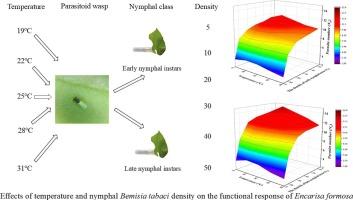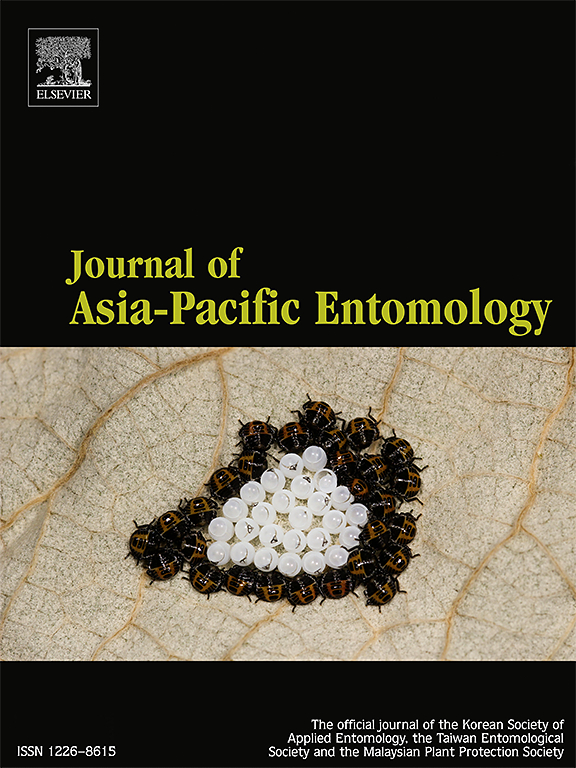不同密度和温度下台湾蜜蜂寄生烟粉虱的功能响应及龄期偏好
IF 1.3
3区 农林科学
Q3 ENTOMOLOGY
引用次数: 0
摘要
烟粉虱(Gennadius)是全球农业生产最严重的威胁之一。利用拟寄生物法对不同作物的烟粉虱进行生物防治是有效的。然而,烟粉虱的生物防治受到多种非生物因素的影响。在这种情况下,了解温度对寄生蜂功效的影响是关键方面之一。在不同温度下,研究了台湾粉虱对烟粉虱早期和晚期若虫的功能反应、搜索效率和寄生偏好。我们发现,在19、22、25、28和31°C时,功能响应符合II型模型。在28℃时,台湾沙蚕对烟粉虱若虫的寄生效率最高。随着寄主密度的增加,台湾人的搜寻效率降低。Hassell-Varley干扰模型模拟结果表明,台湾沙虫存在种内干扰。相较于烟粉虱的早期若虫,台湾粉虱更倾向于寄生于烟粉虱的晚期若虫。综上所述,在25 ~ 31℃条件下,以1:50的寄生蜂对烟粉虱的田间控制效果最佳,成本最低,寄生率最高。本文章由计算机程序翻译,如有差异,请以英文原文为准。

Functional response and instar preference of Encarsia formosa (Hymenoptera: Aphelinidae) parasitizing Bemisia tabaci (Hemiptera: Aleyrodidae) at different densities and temperatures
Bemisia tabaci (Gennadius) is among the most serious threats to global agricultural production. Biological control of B. tabaci using the parasitoid Encarsia formosa Gahan is effective on various crops. However,the biological control of B. tabaci could be affected by various abiotic factors. Understanding the effects of temperature on parasitoid efficacy is one of the key ascpects in this case. In this study, the functional response, searching efficiency, and parasitism preference of E. formosa on early and late nymphal instars of B. tabaci at different temperatures were investigated. We found that the functional response conformed to the type II model at 19, 22, 25, 28 and 31 °C. The parasitoid efficiency of E. formosa toward nymphal B. tabaci was the highest at 28 °C. Searching efficiency of E. formosa decreased with the increase in host density. The Hassell-Varley interference model simulation indicated intraspecific interference in E. formosa. E. formosa preferred to parasitize late instar nymphs of B. tabaci compared to the early instar nymphs. In conclusion, E. formosa releases at 25–31 °C with a parasitoid-to-host ratio of 1:50 is considered optimal to control B. tabaci in field, which minimizes costs and maximizes parasitism rate.
求助全文
通过发布文献求助,成功后即可免费获取论文全文。
去求助
来源期刊

Journal of Asia-pacific Entomology
Agricultural and Biological Sciences-Insect Science
CiteScore
2.70
自引率
6.70%
发文量
152
审稿时长
69 days
期刊介绍:
The journal publishes original research papers, review articles and short communications in the basic and applied area concerning insects, mites or other arthropods and nematodes of economic importance in agriculture, forestry, industry, human and animal health, and natural resource and environment management, and is the official journal of the Korean Society of Applied Entomology and the Taiwan Entomological Society.
 求助内容:
求助内容: 应助结果提醒方式:
应助结果提醒方式:


